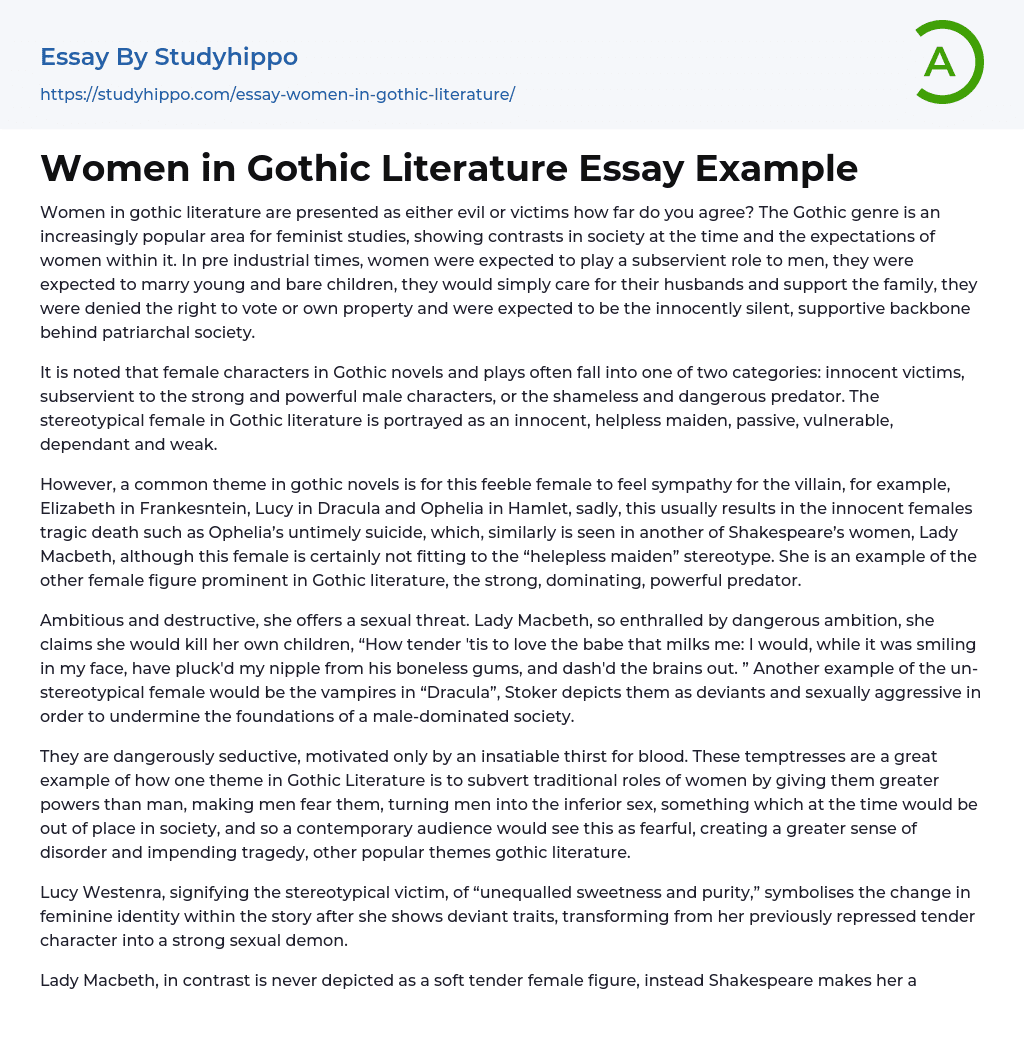It is noted that female characters in Gothic novels and plays often fall into one of two categories: innocent victims, subservient to the strong and powerful male characters, or the shameless and dangerous predator. The stereotypical female in Gothic literature is portraye
...d as an innocent, helpless maiden, passive, vulnerable, dependant and weak.
However, a common theme in gothic novels is for this feeble female to feel sympathy for the villain, for example, Elizabeth in Frankesntein, Lucy in Dracula and Ophelia in Hamlet, sadly, this usually results in the innocent females tragic death such as Ophelia’s untimely suicide, which, similarly is seen in another of Shakespeare’s women, Lady Macbeth, although this female is certainly not fitting to the “helepless maiden” stereotype. She is an example of the other female figure prominent in Gothic literature, the strong, dominating, powerful predator.
Ambitious and destructive, she offers a sexual threat. Lady Macbeth, so enthralled by dangerous ambition, she claims she would kill her own children, “How tender 'tis to love the babe that milks me: I would, while it was smiling in my
face, have pluck'd my nipple from his boneless gums, and dash'd the brains out. ” Another example of the un-stereotypical female would be the vampires in “Dracula”, Stoker depicts them as deviants and sexually aggressive in order to undermine the foundations of a male-dominated society.
They are dangerously seductive, motivated only by an insatiable thirst for blood. These temptresses are a great example of how one theme in Gothic Literature is to subvert traditional roles of women by giving them greater powers than man, making men fear them, turning men into the inferior sex, something which at the time would be out of place in society, and so a contemporary audience would see this as fearful, creating a greater sense of disorder and impending tragedy, other popular themes gothic literature.
Lucy Westenra, signifying the stereotypical victim, of “unequalled sweetness and purity,” symbolises the change in feminine identity within the story after she shows deviant traits, transforming from her previously repressed tender character into a strong sexual demon.
Lady Macbeth, in contrast is never depicted as a soft tender female figure, instead Shakespeare makes her ambitious character apparent from the start, after reading the letter from her husband, telling her about the Witches’ predictions, the seed of ambition grows within her and immediately a plan forms in her head, her first speech is one full of strong metaphors, “come, you spirits that tend on mortal thoughts, unsex me here, and fill me, from the crown to the toe, top full of direst cruelty. This initial speech is so powerful and strong, as she summons spirits to give her the strength of a man, so that she has the vigour
to plot Duncan’s murder, and convince Macbeth to form an alliance with her, ensuring he will become king, just as the Witches predicted. Although the Witches in Macbeth are said to be of no gender, “you should be women, and yet your beards forbid me to interpret that you are so. ” They are referred to as the “Weyward Sister’s”.
These “women” are another example of women being presented as the powerful evil forces which bring about the eventual downfall of protagonists in Gothic literature. After all, without the Witches predictions, it is questionable whether the tragedy which followed would have ever happened. Macbeth in the opening scenes is a well respected man, a worthy fighter, valued by the king and considered an asset and valuable warrior. After his encounter with the Witches, Lady Macbeth, consumed by ambition, greed and a hunger for power, convinces him to betray the king and his friends, turning him from Hero to Villain over night.
Overall it would appear that within gothic literature, female characters tend to fall into two categories, the feeble female, usually met with an untimely end, or the strong domineering villain. Both of which meet with the constraints of patriarchal society at the time, the one, a subservient inferior, and the other, portrayed as a villain, often turning mad or demonstrating signs of ill mental health, such as Lady Macbeth in the sleep walking scene.
The males in gothic novels are in contrast displayed as either the hero or the villain, and in relation to the female, they are either desperate to save them or in fear of them. For example in Dracula, Lucy’s death reiterates the social
restrictions of women in society, returning her back to her previous tender, vulnerable role, as opposed to the strong deviant woman she had become.
- Banquo essays
- Macbeth Ambition essays
- Allegory essays
- Alliteration essays
- Comedy essays
- Comic book essays
- Drama essays
- Dystopia essays
- Fairy Tale essays
- Fantasy essays
- Fiction essays
- Ghost essays
- Gothic Fiction essays
- Gothic Literature essays
- Irony essays
- Legend essays
- Memoir essays
- Novel essays
- Poetry essays
- Satire essays
- Science Fiction essays
- Short Story essays
- The western essays
- Tragedy essays
- Witchcraft essays
- A Doll's House essays
- A Midsummer Night's Dream essays
- A raisin in the sun essays
- A Streetcar Named Desire essays
- An Inspector Calls essays
- Death of a salesman essays
- Everyman essays
- Fences essays
- Hamlet essays
- Hedda Gabler essays
- Iago essays
- King Lear essays
- Macbeth essays
- Much ado about nothing essays
- Oedipus Rex essays
- Oedipus The King essays
- Othello essays
- Pygmalion essays
- Romeo And Juliet essays
- Tartuffe essays
- The glass menagerie essays
- The Importance of Being Earnest essays
- The Merchant Of Venice essays
- The Taming of The Shrew essays
- Twelfth Night essays




